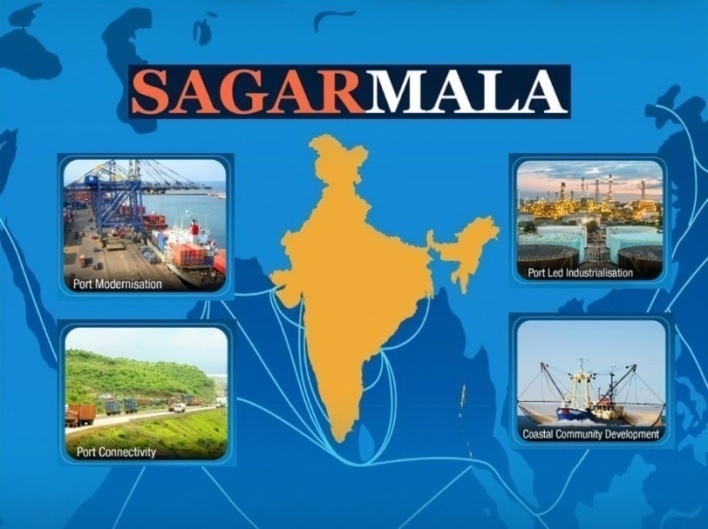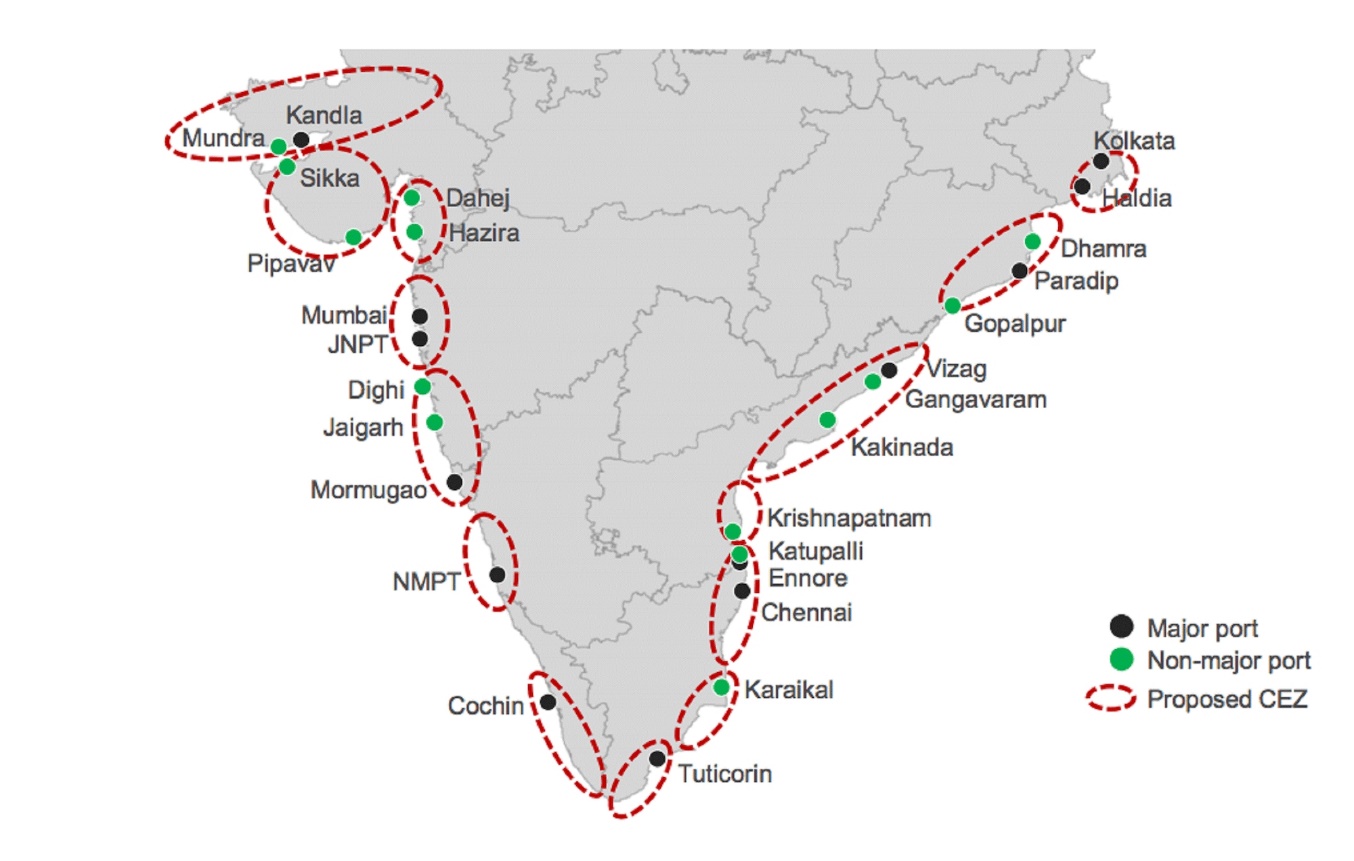Description

Disclaimer: Copyright infringement not intended.
Context
- Ministry of Ports, Shipping and Waterways organized an event to commemorate successful seven years of Sagarmala program.
- The highlight of the event was showcasing the exemplary performance, the flagship program of Ministry of Ports, Shipping and Waterways has achieved during the last 7 years.
About
- The Sagarmala Programme is a huge project taken up by the Indian government to improve the country’s logistic sector.
- This Pariyojana falls under the governance of the Ministry of Shipping of India.
- Covering India’s longest coastline of 7,517 km, waterways of 14,500 km, and global maritime trade pathways, the Sagarmala Project aims to promote industrial port-led development in the country.
Background of Sagarmala Project
- The Indian ports play a primary contributing role in this fast-growing economy.
- In fact, around 95% of merchandise trade passes through Indian seaports. However, the Indian ports still lag in multiple arenas when compared to international ports.
- So, to finally do away with all the issues and develop it even further, the Ministry of Shipping decided to start a new program – The Sagarmala Project.
But, before we jump into the Sagarmala project details, let’s take a look at the 3 major downsides that the Indian ports face.
- Infrastructural Issues: All the Indian ports require proper infrastructure to conquer operational challenges. Over the years, although the operational capability of Indian ports improved, it still had a long way to go to meet international standards.
- Turnaround Time: The TAT (Turnaround Time) at primary ports for India is 2 and a half days. This exceeds by a gap of 24 hours compared to the global average time of only 1 to 1.5 days.
- Lack of Connectivity: Ports along the Indian coastline are not well-connected because of which it takes more time for cargo to reach their destination. This further leads to congestion on the sea routes contributing to more delays, slowing down the entire process. And, while roads and railways are always a viable alternative for goods transportation, it increases the logistics cost and the price of the commodities.
- Using a better interlinking for cargos via inland waterways will reduce transportation costs and the price of industrial commodities such as coal, iron ores, cement, steel, etc.
Aim of Sagarmala Project
The primary aim of the Sagarmala Initiative is as follows:
- Promote direct and indirect development of port-led industries and coastal communities.
- Provide infrastructure to transport goods from one port to another port quickly.
- Save logistics costs and increase efficiency.
- Develop passages to new regions with intermodal solutions to increase the connectivity between ports, rail, inland, coastal, and road services.
- Modernize the primary as well as secondary ports. Make them efficient by developing them economically, transporting assets, creating new links (using various other transport modes), etc.
- Help in establishing industries and manufacturing centers nearby and serve for EXIM and in-country trades.
- Encourage the use of electronic channels to exchange information for a quick, easy, and efficient cargo movement at ports.
- Ensure sustainable living for the people living in and near the Coastal Economic Zone (CEZ), helping them in terms of development, employment, skill development, fisheries, promotion of tourism, and many more.
Why is the Sagarmala Project so Crucial for India?
- With the help of the Sagarmala Project, India can step up their game of trades, logistics, and port development.
- The Sagarmala Project will help in creating an interlinking between railways, roads, and water transports. It will eventually decrease the price of several commodities, as water transport is cheaper by 5%-6% compared to other transportation modes. Further, it will help in increasing the GDP of India.
- Sagarmala Pariyojna can help more than a million people and create full-time jobs for them near coastlines and ports.
- The project will help people living near ports to sustain a better life and earn well. The money will help in the development of rural areas near coastlines or ports. Moreover, better traveling options will increase the tourism of such critical places as well.
- Better port infrastructure and linkages will offer maritime security. Moreover, it is also strategically necessary because of the Maritime Silk Road of China. Never-ending challenges are coming from China. Therefore, India has to have a hold and a connection between ports that can resolve such issues forever.
- Having inland waterways will also promote the savings of logistics costs at a domestic level. It will reduce transportation costs overall.
Which Zones under CEZ are proposed in the Sagarmala Programme?
Here is the list of the 14 Coastal Economic Zones under the Sagarmala Programme:
- Kachchh Coastal Economic Zone
- Saurashtra Coastal Economic Zone
- Suryapur Coastal Economic Zone
- North Konkan Coastal Economic Zone
- South Konkan Coastal Economic Zone
- Dakshin Kanara Coastal Economic Zone
- Malabar Coastal Economic Zone
- Mannar Coastal Economic Zone
- Poompuhar Coastal Economic Zone
- South VCIC Coastal Economic Zone
- Central VCIC Coastal Economic Zone
- North VCIC Coastal Economic Zone
- Kalinga Coastal Economic Zone
- Gaud Coastal Economic Zone

Other Coastal Developments by GOI under Sagarmala Project
- According to the reports, around 18% of Indians live in the 72 districts near the coastal region. Further, these districts consist of 12% of the mainland Indian population.
- The coastal developments by GOI (Government of India) involve activities like fisheries, maritime tourism, skill development for local people, among others under the Sagar Mala Project.
- Additionally, the development of cruise tourism is also a substantial operation taken up to increase employment opportunities and overall growth.
Fisheries Business
- Under the Sagarmala Programme, the Central Ministries and State Governments will collect funds and use them for providing infrastructure facilities, social developmental projects, fisheries business, aquaculture, cold chain development, and more under their governance.
Tourism in Coastal Areas
Under Sagarmala Pariyojna, the Ministry of Tourism and the developmental tourism departments are promoting marine tourism. Here are the following projects they have started working on:
- Coastal circuit development under the Swadesh Darshan Scheme (Ministry of Tourism).
- Promotion of cruise tourism.
- Building Infrastructure to attract more tourists over time.
- Construction of lighthouses to show the way to all ships during bad weather or night.
- Creating several National Maritime Heritage Museums Complex locally.
- Building underwater galleries and restaurants at Beyt Dwarka.
- The Sagarmala Project has also recently launched skill gap studies in over 21 coastal districts of India. The skill development programs are meeting the aims under the unions of Deen Dayal Upadhyaya Grameen Kaushalya Yojana, which falls under the Ministry of Rural Development.
Community Skill Development
- Under the Sagarmala Scheme, the ministries use an integrated approach to improve the quality of life of all people living near coastal areas.
- Skill improvement and training are being provided to the people so that they can earn an adequate earning.
- The plan is to train and make them efficient enough so that they can easily work with the developmental project of Sagarmala.
Primary Characteristics of the Coastal Community Development Plan:
- Develop skills of the local people.
- Promote cruise tourism to create more employment opportunities.
- Build and develop more fishing harbors.
- Perform research and development on ports and marine sectors.
Evaluation of Sagarmala Project
- 802 projects worth Rs. 5.48 lakh Crore under the Sagarmala program targeted to be executed by 2035 out of which 194 projects worth Rs. 99,000 Crore have been completed.
- A total of 29 projects worth Rs. 45,000 Crore have been successfully implemented under PPP model.
- 390 projects worth Rs. 2.37 Lakh Crore are under development pipeline.
- Port connectivity, another important element of the program, has 80 projects under its ambit. These include connectivity infrastructure projects, freight-friendly expressways to enable efficient movement of containers on key routes, and the development of strategic inland waterways.
- Port-led industrialization is being taken up with the aim to boost industrial and export growth along the coastline. This will be realized through 14 Coastal Economic Zones (CEZs) along the coastline.
- Development of a new deep draught port at Vadhavan, on the north coast of Maharashtra is taking shape. The port will cater to Ultra Large Container Vessels (UCLVs).
- Several steps are also being taken towards transitioning major ports to smart ports focusing on Port Community System; Logistics Data Bank Service; RFID Solutions; Enterprise Business Systems; Direct Port Delivery (DPD); Direct Port Entry (DPE); scanners/ container scanners and simplifying the procedures.
Final Thoughts
- The Sagar Mala Project has the ability to make India’s GDP skyrocket with intense and streamlined port operations and coastal community development.
- It has already provided growth, employment, and basic necessities for people living in 72 districts across the coastal region.
- It is estimated that all targets under the Sagarmala Project will be fulfilled by 2035.
- With the Programme moving rapidly every day, the government has been hugely successful in achieving its target so far, and we have complete trust in its abilities, strength, and power.
https://www.pib.gov.in/PressReleasePage.aspx?PRID=1809681















